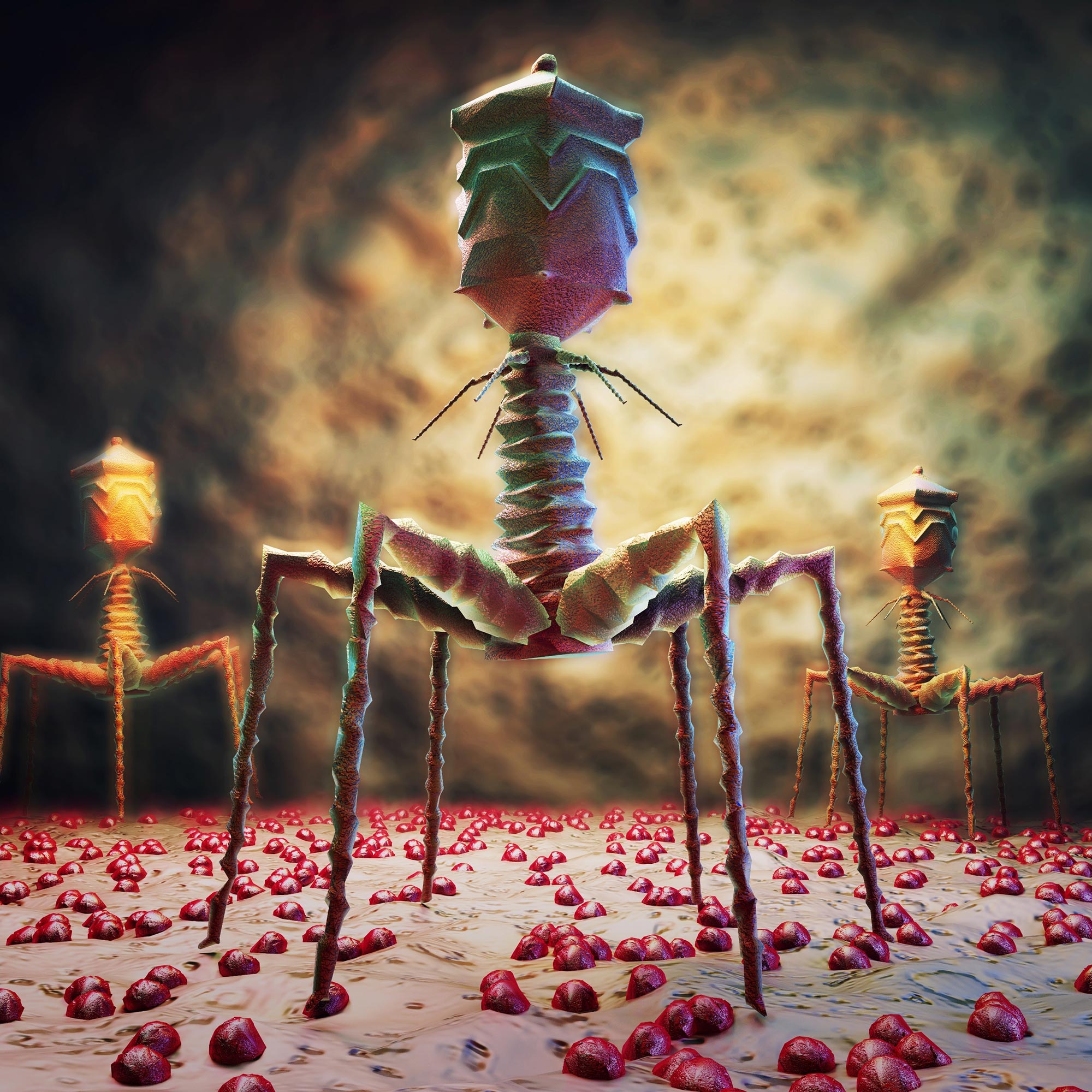噬菌体可以感知细菌 DNA 的损伤,促使它们繁殖并跳槽。
病毒可能正在“监视”你——一些微生物会等到它们的宿主无意中给它们一个信号,开始繁殖并杀死它们。
尤其是两年多之后[{” attribute=””>COVID-19 pandemic, many people picture a virus as a nasty spiked ball – essentially a mindless killer that gets into a cell and hijacks its machinery to create a gazillion copies of itself before bursting out. For many viruses, including the coronavirus that causes COVID-19, the “mindless killer” moniker is essentially true.
However, there’s more to virus biology than meets the eye.
A suitable illustration is HIV, the virus that causes AIDS. HIV is a retrovirus that does not immediately go on a killing spree when it enters a cell. Instead, it integrates itself into your chromosomes and chills, waiting for the proper opportunity to command the cell to make copies of it and burst out to infect other immune cells and eventually cause AIDS.
Bacteriophages, or simply phages, are naturally occurring viruses that attack and kill bacteria. They cannot infect human cells. Phages are extremely diverse and exist everywhere in the environment, including in our bodies. In fact, humans contain more phages than human cells.
A phage has three main parts: a head, a sheath, and a tail. The phage uses its tail to attach to a bacterial cell. They use the bacteria to replicate themselves. After finding a “matching” bacterial cell, the phage injects its genetic material, hijacking the system normally used for bacterial reproduction. Instead the system will make thousands more phages, which ultimately burst the bacterial cell, releasing it into the environment.
Exactly what moment HIV is waiting for is not clear, as it’s still an area of active study. However, research on other viruses has long indicated that these pathogens can be quite “thoughtful” about killing. Of course, viruses cannot think the way you and I do. But, as it turns out, evolution has bestowed them with some pretty elaborate decision-making mechanisms. For example, some viruses will choose to leave the cell they have been residing in if they detect DNA damage. Not even viruses, it appears, like to stay on a sinking ship.
For over two decades, my laboratory has been studying the molecular biology of bacteriophages, or phages for short, the viruses that infect bacteria. Recently, my colleagues and I demonstrated that phages can listen for key cellular signals to help them in their decision-making. Even worse, they can use the cell’s own “ears” to do the listening for them.
Escaping DNA damage
If the enemy of your enemy is your friend, phages are certainly your friends. Phages control bacterial populations in nature, and clinicians are increasingly using them to treat bacterial infections that do not respond to antibiotics.
The best-studied phage, lambda, works a bit like HIV. Upon entering the bacterial cell, lambda decides whether to replicate and kill the cell outright, like most viruses do, or to integrate itself into the cell’s chromosome, as HIV does. If the latter, lambda harmlessly replicates with its host each time the bacteria divides.
该视频显示了感染大肠杆菌的 λ 细菌。
然而,与 HIV 一样,lambda 也不会停滞不前。 像听诊器一样,一种称为 CI 的特殊蛋白质用于聆听细菌细胞内 DNA 损伤的迹象。 如果细菌的 DNA 受损,那对于在其中筑巢的 lambda 蛾来说是个坏消息。 受损的 DNA 直接导致进化的垃圾填埋场,因为它对需要繁殖的噬菌体毫无用处。 因此 lambda 启动其生殖基因,复制自身,然后走出细胞,寻找其他未受损的细胞进行感染。
窃听蜂窝通信系统
一些噬菌体不是用自己的蛋白质收集信息,而是点击受感染细胞的 DNA 损伤传感器:LexA。
CI 和 LexA 等蛋白质是 转录因子 它通过与 DNA 指导手册(染色体)中的特定基因型结合来打开和关闭基因。 一些噬菌体如 Coliphage 186 已经发现,如果它们的染色体中有 LexA 细菌可以附着的短 DNA 序列,它们就不需要病毒 CI 蛋白。 在检测到 DNA 损伤后,LexA 将激活噬菌体的繁殖和杀伤基因,从本质上使细胞穿越到自杀的次数增加一倍,同时允许噬菌体逃逸。
研究人员首次报告 CI 在噬菌体决策中的作用 八十年代 Coliphage 186 反情报把戏 九十年代末. 从那以后,又有一些关于噬菌体窃听细菌通讯系统的报道。 一个例子是 噬菌体phi29,它利用宿主的转录因子来检测细菌何时准备形成孢子或细菌卵的类型 能够在恶劣的环境中生存. Phi29 指示细胞将其 DNA 包装到孢子中,一旦孢子发芽,就会杀死新出现的细菌。
https://www.youtube.com/watch?v=MkUgkDLp2iE
转录因子打开和关闭基因。
在 最近发表的研究,我和我的同事已经证明,几组噬菌体独立进化出利用另一种细菌通讯系统的能力:CtrA 蛋白。 CtrA 整合了多种内源性和外源性信号来驱动细菌的不同发育过程。 其中的关键是细菌生长的产生,称为 鞭子和刷毛. 事实证明,这些噬菌体粘附在细菌的毛发和鞭毛上以感染它们。
我们的主要假设是噬菌体使用 CtrA 来猜测何时有足够的细菌靠近细丝和鞭毛以轻松感染它们。 对于“流浪杀手”来说,这是一个非常聪明的把戏。
这些并不是唯一做出精心决定的噬菌体——所有这些都没有大脑的好处。 一些感染的噬菌体 难的 细菌每次感染细胞时都会产生一个小分子。 噬菌体可以感知和使用这种分子 计算噬菌体感染的数量 围绕着他们转。 像外星入侵者一样,这个数字有助于确定它们何时应该打开繁殖基因并杀死,只有在宿主相对丰富时才会杀死。 通过这种方式,噬菌体确保宿主永远不会耗尽感染并确保它们的长期生存。
反病毒间谍软件
一个很好的问题是您为什么要关心由细菌病毒运行的反间谍软件操作。 虽然细菌与人类非常不同,但感染它们的病毒是 这没有什么不同 感染人类的病毒。 科学 每一个技巧 后来确定噬菌体发挥的病毒被感染人类的病毒使用。 如果噬菌体可以点击细菌的通讯线路,为什么人类病毒不能抓住你?
到目前为止,科学家们还不知道如果人类病毒劫持了这些线路,他们会听什么,但有很多可以想象的选择。 我认为,与噬菌体一样,人类病毒可以通过计算数量来制定策略、检测细胞生长和组织形成,甚至监测免疫反应。 目前,这些可能性只是猜测,但正在进行科学研究调查。
让病毒监听你细胞的对话并不是最乐观的情况,但也不是没有好的一面。 正如世界各地的情报机构所熟知的那样,反情报只有在隐蔽的情况下才能发挥作用。 一旦被检测到,该系统很容易被利用来向你的敌人提供虚假信息。 同样,我相信未来的抗病毒疗法可能能够将传统的大炮(例如阻止病毒复制的抗病毒药物)与信息战欺骗相结合,例如让病毒相信其中的细胞属于不同的组织。
但是,闭嘴,不要告诉任何人。 病毒会听!
由巴尔的摩县马里兰大学生物科学副教授 Evan Earl 撰写。
本文首发于 对话.

“社交媒體傳播者。學生。讀者。麻煩製造者。典型的性格內向。”







More Stories
波音 Starliner 宇航员的首次飞行:实时更新
激光揭示了爱尔兰史前遗址,这些遗址可能是“死者的通道”
日常职业与痴呆症风险增加 37% 相关